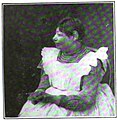Microcephaly
| Microcephaly | |
|---|---|
alcohol consumption while pregnant | |
| Frequency | 2–12 per 10,000 births[1] |

Microcephaly (from
The disorder is caused by a disruption to the genetic processes that
There is no specific treatment that returns the head size to normal.[3] In general, life expectancy for individuals with microcephaly is reduced, and the prognosis for normal brain function is poor. Occasional cases develop normal intelligence and grow normally (apart from persistently small head circumference).[3][9] It is reported that in the United States, microcephaly occurs in 1 in 800-5,000 births.[4]
Signs and symptoms


There are a variety of symptoms that can occur in children.
Severely impaired
Causes
Microcephaly is a type of cephalic disorder. It has been classified in two types based on the onset:[13]
Congenital
This section needs additional citations for verification. (February 2016) |
- Isolated
- Syndromes
- Chromosomal
- Poland syndrome[17]
- Down syndrome[18]
- Edward syndrome[19]
- Patau syndrome[20]
- Unbalanced rearrangements
- Contiguous gene deletion
- 4p deletion (Wolf–Hirschhorn syndrome)
- 5p deletion (Cri-du-chat)
- 7q11.23 deletion (Williams syndrome)
- 22q11 deletion (DiGeorge syndrome)
- Chromosomal
- Single gene defects
- Smith–Lemli–Opitz syndrome
- Seckel syndrome
- Cornelia de Lange syndrome
- Dihydropteridine reductase deficiency - in up to 25% of patients[21]
- 5,10-methenyltetrahydrofolate synthetase deficiency
- Holoprosencephaly
- Primary microcephaly[22]
- Wiedemann-Steiner syndrome
- Acquired
- Disruptive injuries
- Vertically transmitted infections
- Congenital cytomegalovirus infection[24]
- Toxoplasmosis[24]
- Congenital rubella syndrome[24]
- Congenital varicella syndrome[24]
- Zika virus (see Zika fever#Microcephaly)[25]
- Drugs
- Fetal hydantoin syndrome[24]
- Fetal alcohol syndrome[24]
- Other
- Radiation exposure to mother
- Maternal malnutrition[24]
- Maternal phenylketonuria[24]
- Poorly controlled gestational diabetes
- Hyperthermia
- Maternal hypothyroidism
- Placental insufficiency
- Craniosynostosis[24]
Postnatal onset
This section needs additional citations for verification. (February 2016) |
- Genetic
- Inborn errors of metabolism
- Syndromes
- Contiguous gene deletion
- 17p13.3 deletion (Miller–Dieker syndrome)[32]
- Single gene defects
- Rett syndrome (primarily girls)
- Nijmegen breakage syndrome
- X-linked lissencephaly with abnormal genitalia
- Aicardi–Goutières syndrome
- Ataxia telangiectasia
- Cohen syndrome
- Cockayne syndrome
- Contiguous gene deletion
- Acquired
- Disruptive injuries
- Traumatic brain injury[33]
- Hypoxic-ischemic encephalopathy[24]
- Ischemic stroke[23]
- Hemorrhagic stroke[23]
- Infections
- Congenital HIV encephalopathy[34]
- Meningitis[35]
- Encephalitis[36]
- Congenital
- Toxins
- Chronic kidney failure[37]
- Deprivation
- Hypothyroidism[38]
- Anemia[39]
- Congenital heart disease[40]
- Malnutrition[41]
- Disruptive injuries
Genetic mutations cause most cases of microcephaly.
The spread of Aedes mosquito-borne Zika virus has been implicated in increasing levels of congenital microcephaly by the International Society for Infectious Diseases and the US Centers for Disease Control and Prevention.[46] Zika can spread from a pregnant woman to her fetus. This can result in other severe brain malformations and birth defects.[47][48][49][50] A study published in The New England Journal of Medicine has documented a case in which they found evidence of the Zika virus in the brain of a fetus that displayed the morphology of microcephaly.[51]
Microlissencephaly
Historical causes of microcephaly
After the dropping of
Other relations
Intracranial volume also affects this pathology, as it is related with the size of the brain.[58]
Pathophysiology
Microcephaly generally is due to the diminished size of the largest part of the human brain, the
Microcephaly is a feature common to several different genetic disorders arising from a deficiency in the cellular
Treatment

There is no known cure for microcephaly.
History
People with small heads were displayed as a public spectacle in ancient Rome.[69]
People with microcephaly were sometimes sold to
-
18-year-old Emil R., 1868
-
Elderly female, 1888/89
-
36-year-old male, 1894 (normal intelligence present)
-
52-year-old female, 1900
-
10-year-old male, 1904
-
20-year-old female, 1906/07
-
3 relatives, 1913
-
18-year-old sister and 9-year-old brother, 1917
-
55-year-old female, 1920 (linear descendant of Pocahontas)
-
6 siblings, 1920
Notable cases
- A 'dwarf' of Punt (ancient Somalia) was given by the Chief clans as partial tribute to the last ruler of Ancient Egypt's Old Kingdom, Harkhuf! The men in your service [escorts; soldiers; sailors; guards, etc.] ought pay sincere care with the dwarf's head while sleeping during the voyage to the palace" (so that it does not fall off). At the same time, it could be for other reasons unrelated to microcephaly, etc.[73]
- Triboulet, a jester of duke René of Anjou (not to be confused with the slightly later Triboulet at the French court).
- Jenny Lee Snow and Elvira Snow, whose stage names were Pip and Flip, respectively, were sisters with microcephaly who acted in the 1932 film Freaks.
- Schlitze "Schlitzie" Surtees, possibly born Simon Metz, was a widely known sideshow performer and actor, who also appeared in Freaks.
- Lester "Beetlejuice" Green, a member of radio host Howard Stern's Wack Pack.
See also
- Anencephaly (Usually rapidly fatal)
- Cerebral rubicon
- Hydrocephaly
- Macrocephaly
- Seckel syndrome
- Achalasia microcephaly
References
- ^ https://my.clevelandclinic.org/health/diseases/9843-microcephaly Cleveland Clinic. Accessed October 2020
- ^ "Microcephaly - Definition of Microcephaly by Merriam-Webster". Archived from the original on 2014-09-14.
- ^ a b c d e f g h i j "NINDS Microcephaly Information Page". NINDS. June 30, 2015. Archived from the original on 2016-03-11. Retrieved 11 March 2016.
- ^ a b "Facts about Microcephaly | Birth Defects | National Center on Birth Defects and Developmental Disabilities". Centers for Disease Control and Prevention. 2016-12-07. Retrieved 2019-07-30.
- ^ PMID 25951892.
- PMID 12324187.
- PMID 2211965.
- ISBN 978-0721677675.
- S2CID 30379486.
- ^ a b c d "Microcephaly". Stanford Children's Health. Retrieved 2 August 2019.
- ^ "Cephalic Disorders Fact Sheet | National Institute of Neurological Disorders and Stroke". www.ninds.nih.gov. Retrieved 2019-08-02.
- ^ "Microcephaly with Spastic Quadriplegia disease: Malacards - Research Articles, Drugs, Genes, Clinical Trials". www.malacards.org. Retrieved 2019-08-02.
- PMID 19752457.
- ^ a b "Microcephaly in Children". Health Encyclopedia. University of Rochester Medical Center. Retrieved 2019-07-30.
- ^ "Microcephaly autosomal dominant". Genetic and Rare Diseases Information Center. Archived from the original on 2020-09-21. Retrieved 2019-07-30.
- ^ "OMIM Entry - # 617520 - microcephaly 18, primary, autosomal dominant; MCPH18". www.omim.org. Retrieved 2019-07-30.
- ^ "Poland syndrome". Genetic and Rare Diseases Information Center. Retrieved 2019-07-30.
- ^ "Microcephaly". World Health Organization. Retrieved 2019-07-30.
- ^ "Trisomy 18: MedlinePlus Medical Encyclopedia". medlineplus.gov. Retrieved 2020-10-29.
- ^ "Trisomy 13 | Genetic and Rare Diseases Information Center (GARD) – an NCATS Program". rarediseases.info.nih.gov. Retrieved 2020-10-29.
- PMID 32456656.
- S2CID 2295608.
- ^ a b c d "Microcephaly in infants and children: Etiology and evaluation". UpToDate. Retrieved 2019-08-02.
- ^ a b c d e f g h i j "Microcephaly - Symptoms and causes". Mayo Clinic. Retrieved 2019-07-30.
- PMID 26796813.
- ^ "Congenital Disorders of Glycosylation". NORD (National Organization for Rare Disorders). Retrieved 2019-08-01.
- ^ "Mito Info". Mito Foundation. Retrieved 2019-08-01.
- ^ "Zellweger syndrome". Orphanet. Retrieved 2019-08-01.
- ^ Reference, Genetics Home. "GLUT1 deficiency syndrome". Genetics Home Reference. Retrieved 2019-08-01.
- ^ "Maternal phenylketonuria". Orphanet. Retrieved 2019-08-01.
- PMID 29757724.
- ^ "OMIM Entry - # 247200 - Miller-Dieker Lissencephaly Syndrome; MDLS". OMIM. Retrieved 2019-08-01.
- PMID 29763011, retrieved 2019-07-30
- PMID 25598835.
- PMID 25919727.
- S2CID 31790738.
- ^ "Galloway-Mowat Syndrome". NORD (National Organization for Rare Disorders). Archived from the original on 2021-03-11. Retrieved 2019-08-02.
- PMID 24665922.
- ^ Reference, Genetics Home. "Fanconi anemia". Genetics Home Reference. Retrieved 2019-08-02.
- PMID 19576365.
- ^ "Facts about Microcephaly". Centers for Disease Control and Prevention. 2016-12-07. Retrieved 2019-08-02.
- PMID 19955444.
- PMID 18668038.
- PMID 19850849.
- PMID 20080800.
- ^ "Zika virus - Brazil: confirmed Archive Number: 20150519.3370768". Pro-MED-mail. International Society for Infectious Diseases. Archived from the original on 2016-01-30.
- S2CID 20675635.
- ^ "CDC Concludes Zika Causes Microcephaly and Other Birth Defects". CDC. 13 April 2016. Archived from the original on 31 May 2016. Retrieved 1 June 2016.
- ^ "CDC issues interim travel guidance related to Zika virus for 14 Countries and Territories in Central and South America and the Caribbean". Centers for Disease Control and Prevention. 2016-01-15. Archived from the original on 2016-01-18. Retrieved 2016-01-17.
- ^ Beth Mole (2016-01-17). "CDC issues travel advisory for 14 countries with alarming viral outbreaks]". Ars Technica. Condé Nast. Archived from the original on 2016-01-18. Retrieved 2016-01-17.
- S2CID 205099844.
- PMID 28969387.
- ISBN 978-1455753604.
- ISBN 9780323295376.
- ^ "Aftereffects". Archived from the original on 2009-05-25.
- ^ ISBN 9789048188208.
- PMID 14173443.
- PMID 27694991.
- PMID 26022163.
- PMID 22031906.
- PMID 20118933.
- PMID 21529751.
- PMID 29643508.
- PMID 27038591.
- PMID 27179424.
- PMID 18458003
- ^ Ribeiro JH, Altinisik N, Rajan N, Verslegers M, Baatout S, Gopalakrishnan J, Quintens R. DNA damage and repair: underlying mechanisms leading to microcephaly. Front Cell Dev Biol. 2023 Oct 10;11:1268565. doi: 10.3389/fcell.2023.1268565. PMID: 37881689; PMCID: PMC10597653
- S2CID 35908740.
- ISBN 978-9-949-51606-3.
- S2CID 207118420.
- ^ "Zip the Pinhead: What is it?". The Human Marvels. 16 October 2010. Archived from the original on 14 April 2016.
- ^ "Interview with Bill Griffith". ZippythePinhead.com. Goblin Magazine. 1995. Archived from the original on 31 January 2012. Retrieved 13 February 2013.
- (PDF) from the original on 17 May 2017. Retrieved 17 February 2018.











